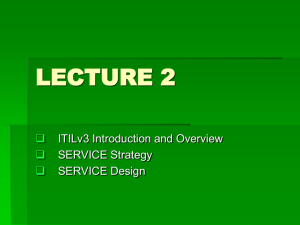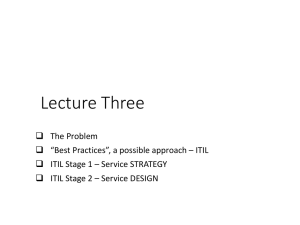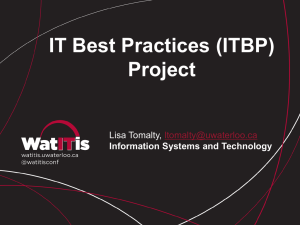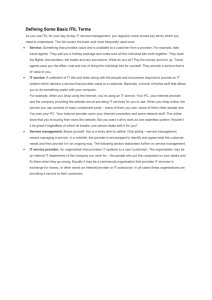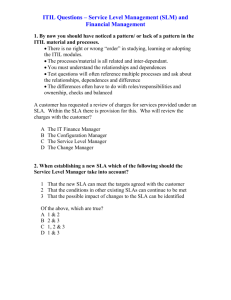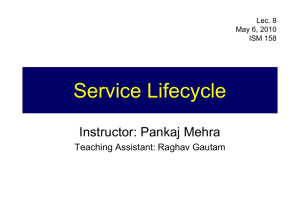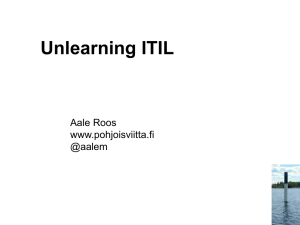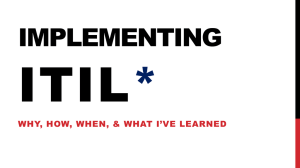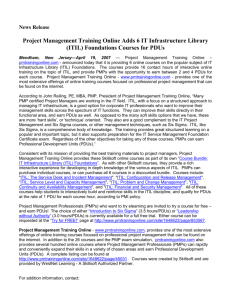Document
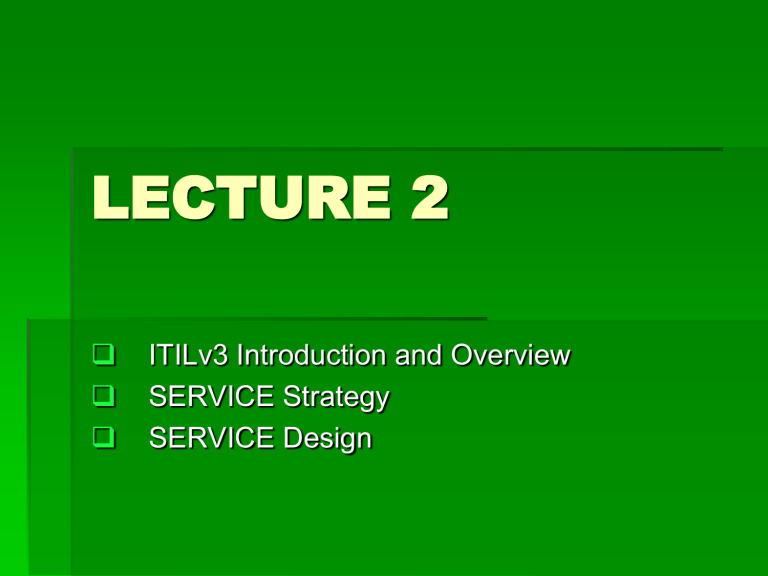
LECTURE 2
ITILv3 Introduction and Overview
SERVICE Strategy
SERVICE Design
Introduction & Overview
What is ITIL?
What about v3?
Key Concepts
Service Management & Delivery
The Five Stages of the lifecycle
ITIL Roles
Functions and Processes
What is ITIL? (1/2)
What is ITIL? (2/2)
Systematic approach to high quality IT service delivery
Documented best practice for IT Service
Management
Provides common language with welldefined terms
Developed in 1980s by what is now The Office of Government
Commerce
I nformation
T echnology
I nfrastructure
L ibrary ( 5 Books )
What about v3?
ITIL started in 80s.
40 publications!
v2 came along in 2000-2002
Still Large and complex
8 Books
Talks about what you should do
v3 in 2007
Much simplified and rationalised to 5 books
Much clearer guidance on how to provide service
Easier, more modular accreditation paths
Keeps tactical and operational guidance
Gives more prominence to strategic ITIL guidance relevant to senior staff
Aligned with ISO20000 (1st international standard for IT service management, mostly based on ITIL – 2005)
Expecting v4?
The Friday 29th July 2011 Update will see the launch of the updated ITIL Core Publications , currently being referred to as
ITIL 2011.
It is not ITIL v4 , simply ITIL v3 being updated . The process of
Continual Service Improvement or CSI is being applied to the IT
Infrastructure Library. A log has captured errors, inconsistencies, suggestions, clarifications and expanded explanations since the launch of ITIL v3 in 2007. Each will be analyzed and reviewed by a Change Advisory Board (CAB) and approved by the owners of
ITIL, the Office of Government Commerce (OGC). The OGC has stated that the updates are not being made for 'revenue generating' purposes.
Key Concepts (1/4)
Service
Delivers value to customer by facilitating outcomes customers want to achieve without ownership of the specific costs and risks
e.g. a “backup service” means that you don’t have to care about how much tapes, disks or robots cost and you don’t have to worry if one of the staff is off sick or leaves
Key Concepts (2/4)
Service Level
Measured and reported achievement against one or more service level targets. E.g.:
Red = 1 hour response 24/7
Amber = 4 hour response 8/5
Green = Next business day
Key Performance Indicators (KPIs)
Quantifiable measurements that reflect the critical success factors of an organization (KPIs usually are long-term considerations)
Service Level Agreement (SLA)
Written and negotiated agreement between
Service Provider and Customer documenting agreed service levels and costs
Key Concepts (3/4)
Configuration Management System ( CMS )
Tools and databases to manage IT service provider’s configuration data
Contains Configuration Management Database (CMDB)
Records hardware, software, documentation and anything else important to IT provision
Lot of tools vendors: IBM ( Tivoli ), BMC ( Atrium ), HP,
Microsoft, CA, …
Release
Collection of hardware, software, documentation, processes or other things require to implement one or more approved changes to IT Services
Key Concepts (4/4)
Incident
Unplanned interruption to an IT service or an unplanned reduction in its quality
Problem
Unknown (… as briefly as possible …) underlying cause of one or more incidents
Work-around
Reducing or eliminating the impact of an incident without resolving it
4 P ’s of Service
Management
P eople – skills, training, communication
P rocesses – actions, activities, changes, goals, improving paths
P roducts – tools, monitors, measures, documents
P artners – specialist suppliers
Service Delivery Strategies
Strategy
In-sourcing
Out-sourcing
Co-Sourcing
Knowledge Process Outsourcing
(domain-based business expertise)
Application Outsourcing
Business Process Outsourcing
Partnership/Multi-sourcing
Features
All parts internal
External resources for specific and defined areas (e.g. Contract cleaners)
Mixture of internal and external resources
Outsourcing of particular processes, with additional expertise from provider
External hosting on shared computers
– applications on demand (e.g. Survey
Monkey, Meet-o-matic)
Outsourcing of specific processes e.g.
HR, Library Circulation, Payroll
Sharing service provision over the lifecycle with two or more organisations
Service Delivery Levels
Application SW
SaaS – Software as a
Service
OS & Middleware PaaS – Platform as a
Service
HW & Bld
Infrastructures
IaaS – Infrastructures as a Service
The Service Lifecycle & the
5 Lifecycle Stages
Processes & Functions
Process
Structured set of activities designed to accomplish a defined objective
Inputs & Outputs
Measurable
Function
Team or group of people and tools they use to carry out one or more processes or activities
Own practices and knowledge body
ITIL Roles ( Owner vs. Manager )
Process Owner
Ensures Fit for Purpose
Process Manager
Monitors and Reports on Process
Service Owner
Accountable for Delivery
Service Manager
Responsible for initiation, transition and maintenance. Lifecycle!
… more Roles
Business Relationship Manager
( 清 洁公司 ةفاظن دهعتم )
Service Asset & Configuration
Service Asset (resources) Manager
Service Knowledge (capabilities) Manager
Configuration Manager
Configuration Analyst
Configuration Librarian
CMS tools administrator
The 5 Service Lifecycle Stages
• Service Strategy
– Strategy generation
– Financial management
– Service portfolio management
– Demand management
• Service Design
– Capacity, Availability, Info
Security Management
– Service level & Supplier
Management
• Service Transition
– Planning & Support
– Release & Deployment
– Asset & Config management
– Change management
– Knowledge Management
• Service Operation
– Problem & Incident management
– Request fulfilment
– Event & Access management
• Continual Service
Improvement
– Service measurement & reporting
– 7-step improvement process
Stage 1 – Service Strategy
What are we going to provide?
Can we afford it?
Can we provide enough of it?
How do we gain competitive advantage?
Perspective
Vision, mission and strategic goals
Position
Plan
Pattern
Must fit organisational culture
Service Strategy has four activities
Define the Market
Develop the Offerings
Develop Strategic Assets
Prepare for Execution
Service Assets
Resources
Things you buy or pay for
IT Infrastructure, people, money
Tangible Assets
Capabilities
Things you grow
Ability to carry out an activity
Intangible assets
Transform resources into Services
Service Portfolio
Management
Prioritises and manages investments and resource allocation
Proposed services are properly assessed
Business Case
Existing Services Assessed. Outcomes:
Replace
Rationalise
Renew
Retire
Demand Management
Ensures we don’t waste money with excess capacity
Ensures we have enough capacity to meet demand at agreed quality
Patterns of Business Activity to be considered
E.g. Economy 7 electricity, Congestion
Charging, …
Stage 2 – Service Design
How are we going to provide it?
How are we going to build it?
How are we going to test it?
How are we going to deploy it?
Holistic approach to determine the impact of change introduction on the existing services and management processes
Processes in Service
Design
1.
Service Catalogue Management
2.
Service Level Management
3.
Capacity Management
4.
Information Security Management
5.
Availability Management
6.
ITSCM (disaster recovery)
7.
Supplier Management
P#1 – Service Catalogue
Business Process A
Service 1 Service 2
Business Process B
Business Service Catalogue
Service 3 Service 4
Technical Service Catalogue
Business Process C
Service 5 Service 6
Hardware Software Support Applications
Databases
Capability
Keeps service information away from business information
Provides accurate and consistent information enabling service-focussed working
P#2 – Service Level Management
Service Level Agreement ( SLA )
Operational Level Agreements
Internal
Underpinning Contracts (“ SLAs are for service management, contract is for the court ...”)
External Organisation
Supplier Management
Generally an annexe to a contract
Should be clear and fair and written in easy-tounderstand, unambiguous language
Success of SLM: Key Performance
Indicators ( KPIs )
How many services have SLAs?
How does the number of breaches of SLA change over time (we hope it reduces!)?
Things you might find in an SLA
Service
Description
Hours of operation
User Response times
Incident
Response times
Resolution times
Customer
Responsibilities
Critical operational periods
Availability &
Continuity targets
Change
Response
Times
Types of SLA
Service-based
All customers get same deal for same services
Customer-based
Different customers get different deal (and different cost)
Multi-level
These involve corporate, customer and service levels and avoid repetition
SLA, an example
Online Services Availability
Minutes of service unavailability
Period 1 definition: MON-FRI 8-18
Period 2 definition: other
Observation interval 1 YEAR:
“ Inappropriate ” SL: more than 523 min/year in period 1, more than 680 in period 2
“ Insufficient ” SL: more than 756 min/year in period 1, more than
983 in period 2
“ Unsuitable ” SL: more than 1.047 min/year in period 1, more than 1.361 in period 2
Observation interval 1 MONTH:
“ Inappropriate ” SL: n/a
“ Insufficient ” SL: n/a
“ Unsuitable ” SL: more than 209 min/month in period 1, more than 272 in period 2
SLA, more examples
Online Services Performance
Transactions mean response time ≤ 2,5 sec
Maximum percentage of transactions ending in more than 1 sec = 5%
DR Service
RTO (Recovery Time Option):
Applications A, B, C, ... restarting in 2 hours after the disaster formal statement
Applications X, Y, Z, ... restarting in 24 hours after the disaster formal statement
RPO (Recovery Point Option):
No data loss for applications A, B, C, ...
Maximum data loss for applications X, Y, Z, ... updates in the last hour before the disaster
P#3 – Capacity Management
Right Capacity, Right Time,
Right Cost!
Balances Cost against
Capacity so minimises costs while maintaining quality of service
P#4 – Information Security Management
Confidentiality
Making sure only those authorised can see data
Integrity
Making sure the data is accurate and not corrupted
Availability
Making sure data is supplied when it is requested
P#5 – Availability Management
Ensure that IT services are available … minimum at the agreed targets
Lots of Acronyms
Mean Time Between Service Incidents
Mean Time Between Failures
Mean Time to Restore Service
Resilience increases availability
Service can remain functional even though one or more of its components have failed
P#6 – ITS C M
IT S ervice C ontinuity M anagement
Ensures resumption of services within agreed timescale
Business Impact Analysis informs decisions about resources
E.g. Stock Exchange can’t afford 5 minutes downtime but 2 hours downtime probably wont badly affect a departmental accounts office or a college bursary
Standby for liftoff...
Cold
Accommodation and environment ready but no IT equipment … WEEKS
Warm
As cold plus backup IT equipment to receive data … 24
48 HOURS
Hot
Full duplexing, redundancy and failover
… MINUTES
COUPLE of HOURS
Not to be confused … (1/2)
Business Continuity
Today IT is often a vital mechanism of the whole complex
“business machine” … but business’ proper functioning also needs: People, building, no-IT tools, rules and procedures, documents, money, decisions, … and more and more …
“Business Continuity” is a set of MAINLY
ORGANIZATIONAL measures to ensure that Business can go on (downgraded at worst) with one or more unavailable assets
IT Continuity
A set of MAINLY TECHNICAL measures to reduce the unavailability of the IT services
Part of business continuity
Not to be confused … (2/2)
IT Availability Management
The process that defines SLA on IT Services availability and provides their compliance
IT Continuity Management
The process by which PROACTIVE measures are put in place and managed to ensure that IT Services can continue should an incident occur
Disaster Recovery
A set of REACTIVE processes activated to recover IT
Services after a serious incident has occurred
Contingency Plan
A set of business emergency procedures to be used during missing or severe defecting IT Services
P#7 – Supplier Management
To ensure that all contracts with suppliers support the needs of the business, and that all suppliers meet their contractual commitments :
Providing the Supplier Management Framework
Evaluation of New Suppliers and Contracts
Establishing New Suppliers and Contracts
Processing of Standard Orders
Supplier and Contract Review
Contract Renewal or Termination
